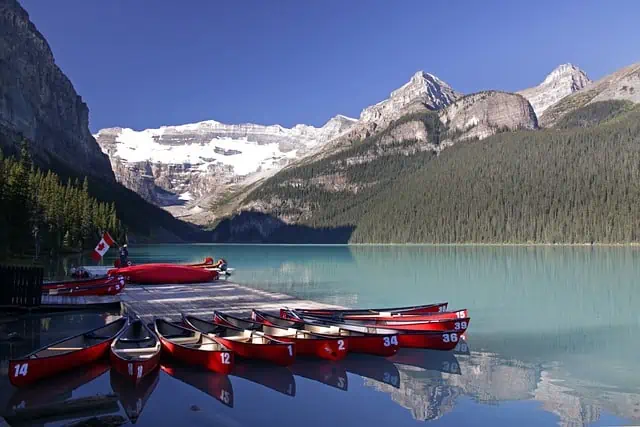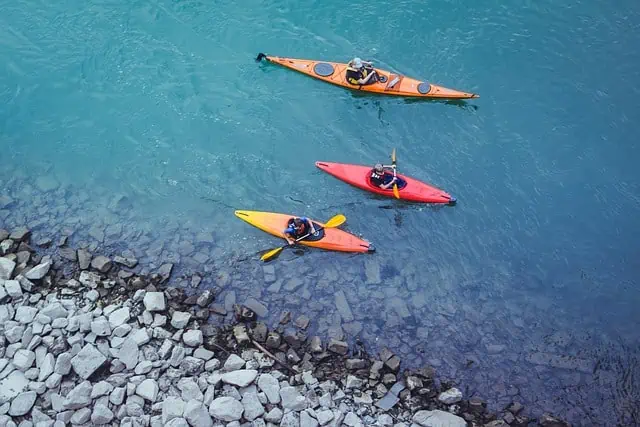Both Kayaking and canoeing are very popular water activities and each has its unique charm. However, there are differences between kayaks and canoes, and understanding them will be interesting for both enthusiasts and beginners to these two activities. These differences include designs, paddling techniques, use cases, and much more, and in this article, we will analyze them one by one.
The main differences between Kayaks and Canoes
Kayaks
A kayak is a small, narrow watercraft with a covered deck and a cockpit where the paddler sits. It is designed for smooth, agile, and efficient handling through a variety of water conditions. Kayaks are usually intended for one or two occupants who use double-bladed paddles to propel themselves.
Suggested Read – Kayaking In Los Angeles
Canoes
A canoe is an open-top boat often associated with traditional and recreational activities. It features an open hull with high sides and can accommodate multiple occupants. Canoes are propelled using single-bladed paddles and can be used for fishing, nature trips, or leisurely canoeing.
Design and Purpose

Although seem similar at first glance, there are distinct differences between kayaks and canoes. In this section, let’s explore the design and purpose of each, providing a broader understanding of kayaks and canoes.
Kayak Design and Purpose
As for the shape of the kayak, it has a pointed bow and a circle that allows for smooth movement through the water. Kayaking has enclosed cockpits that protect the paddler and reduce the risk of water entering the boat. Some kayaks have two enclosed cockpits for two paddlers. In addition, the kayak’s height from the water surface is minimal, which helps to reduce the kayak’s weight and wind resistance, and the narrow hull makes it easier to maneuver and increase speed. These are specially designed for specific purposes including touring, recreational riding, fishing, and whitewater kayaking.
Suggested Read – Kayaking In Costa Rica
Canoe Design and Purpose
Canoes are mainly designed with heavy-weight transportation in mind. Due to their size and stability, canoes excel at carrying gear and passengers on long journeys. They are widely used for exploring calm lakes, rivers, and estuaries and provide ample space for camping gear and provisions, plus, the open deck makes it very easy to load and unload cargo or take passengers in and out. A canoe is slightly larger than a kayak, so it has more resistance to water and wind, making it a bit more difficult to handle, but canoes designed specifically for racing are streamlined in shape and lightweight giving priority to speeding and maneuverability.
Stability and Maneuverability
In this chapter, we will delve into the nuances of stability and maneuverability, exploring how there are differences between kayaks and canoes. So, let’s paddle through the details
Kayak Stability
Stability is one of the most important things to take into account when comparing the difference between kayaks and canoes. Kayaks are renowned for their exceptional stability, which makes it easy for paddlers to navigate through turbulent and rocky waters. Kayaks retain superior balance due to their thinner hull and lower center of gravity, which makes them ideal for more daring water sports like sea kayaking and whitewater kayaking.
The design of both kayaks and canoes impacts their maneuverability. Due to their sleek and narrow build, kayaks excel in maneuvering through narrow passages and tight turns. The double-bladed paddle allows for efficient and precise paddling on both sides, making it easier to navigate tricky waters. This level of control is particularly essential in activities like whitewater kayaking or sea kayaking, where quick turns and precise navigation are crucial.
Canoe Stability
Canoes, on the other hand, provide a different kind of stability. They have a wider and flatter hull, offering more initial stability. However, canoes may not be as stable in rough waters, and beginners might find them slightly more challenging to maneuver.
canoes offer a different kind of maneuverability. With the use of a single-bladed paddle, paddlers can handle changes in direction with grace. Canoes are versatile for smooth paddling on open water and with more passengers and storage capacities.
Seating Arrangements
In this section, we shed light on the differences between kayaks and canoes about seating.
Kayak Seating Arrangements
The kayak has a unique seating arrangement that improves balance, maneuverability, and control. The seat of the kayak is designed so that the rider sits in an enclosed cockpit with their legs extended away from the body. This design allows for a lower center of gravity to help keep the kayak more stable in rough water.
Canoe Seating Arrangements
Canoes typically provide an open and spacious design that facilitates flexible seating arrangements. They often have benches running across the width of the boat, allowing multiple individuals to sit side by side. This seating arrangement promotes comfort, teamwork, and efficient weight distribution.
Types and Activities

Kayaks and canoes offer exciting and adventurous experiences, with different types used for different activities. Let’s find out what they are in detail in this chapter
Types of Kayaks
- Recreational Kayaking
Pond Kayaks are small and easy to handle with low skill. Also, it is comfortable and stable, ideal for navigating waterways, watching wildlife, or floating on a pond or lake. Pond Kayaks are shorter in length, which makes the boat easier to maneuver in shorter waterways, and are ideal for poking into small coves and creeks. And these boats are relatively wider than others. This is because they are shorter and require extra width to provide buoyancy. The advantage here is that boats are more stable, while the added width helps provide more room for comfortable seating.
- Sea Kayaking
Sea kayaks were originally designed for use on the ocean, and are designed to efficiently navigate long distances on any large body of water. Its origins are the closest ancestors of early kayaks created by the Inuit and Aleut peoples of the Arctic. These early kayaks were often quite narrow and long. This shape helps to move efficiently through the water even when the waves are bigger with the wind. Sea kayaks are usually designed with a small cockpit. Because of the length of the boat, generally heavier than recreational kayaks, while the length makes them less maneuverable for exploring small caves and creeks.
- Tandem Kayaks
Traditionally kayaks have only been able to accommodate one paddler in a single boat, but tandem or double kayaks are a great way for two paddlers to go to the water together. Working together in one boat can go faster than going it alone. This is especially useful for a novice, less experienced paddler on a trip with a strong, experienced paddler. Multi-person kayaks have a large cockpit or separate cockpits for each paddler.
- Racing kayaks
There are many different types of racing kayaks and almost all of them have characteristics of speed. These boats have several factors that contribute to speed. Among them, the long boats and less submerged in the water are the main factors to boost the speed. Keeping these factors in mind, these kayaking boats are designed to glide in the water at high speed.
Suggested Read – More Different Types of Kayaks
Types of Canoe
- Solo Canoes
Designed for individual use, solo canoes offer unparalleled maneuverability and ease of use. These compact and lightweight canoes provide excellent control, allowing you to navigate swiftly through narrow and winding waterways. Solo canoes are an ideal choice for solo explorers or those seeking solitude on the water.
- Recreational Canoes
Recreational canoes offer stability, and ample storage space, and are generally wider, making them suitable for calm lakes and rivers. Recreational canoes are perfect for fishing, picnics, and leisurely paddling with friends and family.
- Touring Canoes
For those seeking extended journeys or multi-day camping trips, touring canoes are designed to withstand rugged landscapes and carry heavier loads. With increased stability, superior tracking capabilities, and extended durability, touring canoes are built to handle rough waters and challenging environments. They provide ample space for gear and possess enhanced maneuverability.
- Whitewater Canoes
whitewater canoes are specifically designed for maneuverability, enabling you to navigate swiftly through rapids and challenging terrains. Whitewater canoes feature a more aggressive shape and are typically made with durable materials for maximum durability and protection.
Suggested Read – More Types of Canoes
Conclusion
Kayaks and canoes each have unique features that cater to different water activities and preferences. We hope that, whether you’re looking for speed, solo adventures, or family outings, understanding the differences between kayaks and canoes like the one in this article will help you make an informed choice and fully enjoy your water adventures.


